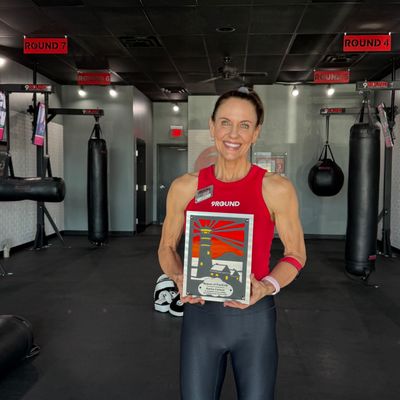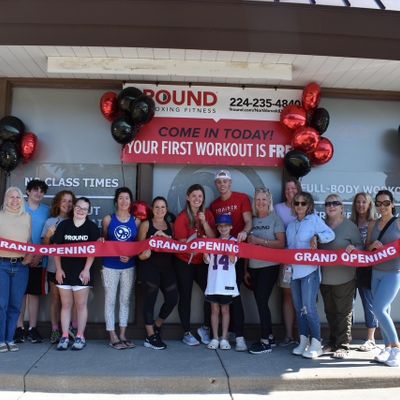A Beginner’s Guide to Fitness Terminology

Interpreting fitness lingo at the studio can often feel like you’re trying to decipher an entirely new language. In some ways, that’s exactly what you’re doing when you begin working out and trying to immerse yourself into common gym culture. However, when trainers and members start throwing around terms you’ve never heard before, don’t sweat it! Just come back to this beginner’s guide to fitness terminology to catch up on all the important words you need to know when working out!
P.S. – if you’re already up-to-speed on your common fitness terminology, then don’t forget to check out our 9Round-specific guide to learn more about the jargon we use inside our studios.
Aerobic
When you hear someone talking about aerobic exercise, they’re referring to an activity that’s intended to improve your cardiovascular system’s ability to absorb and transport oxygen. During aerobic exercise, your body utilizes oxygen for energy to keep you moving for a longer period of time. This makes aerobic exercise great for improving endurance as well. Examples of aerobic exercise include running, swimming, jumping rope, and cycling.
AMRAP
AMRAP stands for “as many reps as possible.” This is often used during high-intensity workouts to challenge you to push yourself harder for a given time period to see how many reps you can complete before your time is up. A good example of when we use AMRAP at 9Round is during the weekly CHOW or during our special MAX OUT Workout, where to goal is to do as many reps as possible to see how high you can get your number compared to other 9Rounders.
Anaerobic
Whereas aerobic exercise is based on oxygen consumption, anaerobic exercise is based on glucose consumption (sugar from carbohydrates). In fact, the term “anaerobic” means “without oxygen.” This type of exercise involves shorter bursts of energy that can only be sustained for a short period of time. Because of this, your body converts glucose into energy for your muscles, as it delivers nutrients much faster than aerobic exercise, but glucose stores are limited making it difficult to do anaerobic exercise for long periods of time.
Cardio
You probably hear the word “cardio” thrown around quite a bit at the studio, and for good reason! This refers to the type of exercise that’s intended to improve your heart and cardiovascular system, so your body can pump oxygen and nutrients to your muscles more efficiently. You can condition your cardiovascular system to work harder over time with regular exercise, which can reduce your risk of heart-related illnesses later in life. During cardio exercise, you aim to keep your heart rate elevated in the ideal zones for burning fat and improving strength.
Circuit
A circuit training workout involves cycling through different exercises with minimal rest in between. Typically, this format lends circuit-based workouts to be shorter and more intense compared to other exercise options. 9Round follows a simple nine-round circuit routine where you move from one round to the next with a 30-second break in between.
Compound Exercise
We love incorporating compound exercises into your 9Round workout because they focus on working several different muscle and joint groups all at once. Examples of compound exercises includes squats, push-ups, and all those KILLER kicks we do at the studio to help you train your legs and your core at the same time. Take a look at this blog if you want to learn more about the benefits of compound exercises.
DOMS
DOMS stands for “delayed onset muscle soreness,” and this typically sets in within 24 to 48 hours following an intense workout. DOMS is caused by small micro tears that happen in your muscle fibers during your workout, and the discomfort from DOMS can last for up to 72 hours or longer. As these micro tears begin to heal, our muscles will grow bigger and stronger to help our body overcome new stressors. This is how strength #gains are made. If you experience DOMS, you want to give your body time to rest, so focus on more low-intensity exercises or take an active rest day instead.
EPOC
Have you ever heard someone talk about EPOC or the “afterburn” of working out? This process is known as excess post-exercise oxygen consumption, and it’s the reason why you can continue burning calories throughout the day long after you’ve finished exercising. In a nutshell, EPOC refers to the amount of oxygen required to restore your body to its normal, resting state following a tough workout. If you’re curious to learn more, then check out this 9Round blog on EPOC.
HIIT
This acronym stands for “high-intensity interval training,” and it’s one way to describe our KILLER 9Round workouts. HIIT typically involves several high-intensity exercises followed by brief periods of rest — for example, we have nine rounds of intense exercise for three minutes each followed by 30 second active breaks. The first 2.5 minutes of a round is considered moderate intensity while the last 30 seconds are for burning it out before the active rest. We like to say you’re “sprinting to the finish line” during those last 30 seconds!
This type of exercise is great for enhancing your cardiovascular fitness and burning fat, as it pushes your heart rate to its maximum for a short period of time and then brings it back down again during the rest interval. This is how our KILLER 9Round workouts help you get both aerobic and anaerobic exercise in just 30 minutes.
Hypertrophy
When you start working out, especially when you want to build strength, you might hear your trainers talk about hypertrophy. This common term simply refers to the process of increasing and growing your muscles through exercise, or #strengthgains. Participating in regular exercise each week can encourage hypertrophy to help your muscles grow bigger and stronger.
Reps (Repetitions)
Reps or repetitions are the number of times you’re given to complete a particular exercise. A single rep can include just one specific move, like a squat or push-up, or they can encompass more than one move. For example, on Round 2 of your KILLER workout, a full rep might be a squat with 2 alternating front kicks + a bicep curl.
Resistance Training
Resistance training is a form of exercise that focuses on building muscle strength and endurance. There are a number of ways to incorporate resistance training into your routine, but two of the most common options are using weights and/or machines or bodyweight exercises. 9Round takes advantage of using both bodyweight exercises and weights, as well as a unique form of resistance training you get from punching and kicking heavyweight bags during our KILLER workouts!
DYK: The various kickboxing bags we use can weigh anywhere between 65 and 105 pounds? This helps provide a ton of resistance each time you make contact with a bag!
Sweaty Selfie
This is what you use to commemorate your KILLER workout! Simply take out your phone at the end of your session to snap a quick photo to share on your Instagram or Facebook page to let everyone know you totally crushed it!


